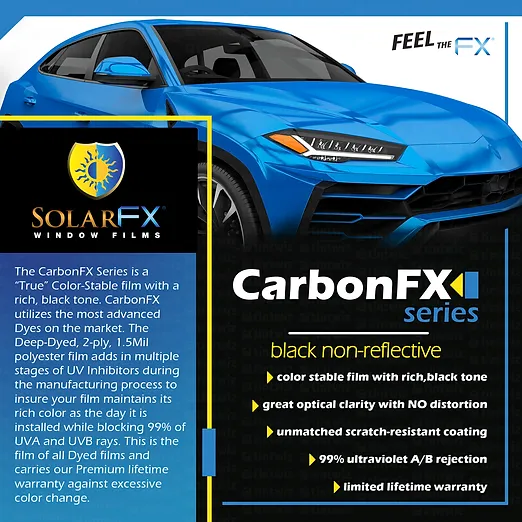











Carbon window tint is known for its durability and resistance to fading over time. It tends to hold up well against prolonged exposure to sunlight and other environmental factors. While carbon window tint is not the cheapest option on the market, it often falls in the mid-range in terms of cost. The benefits it offers in terms of heat rejection, UV protection, and aesthetics can justify the investment for many car owners.

Nano-Ceramic window film offers the maximum heat rejection and performance of any film. Ceramic tint provides excellent protection against harmful ultraviolet (UV) rays from the sun. UV rays can cause fading and damage to the interior of a car or home, as well as pose health risks to occupants. Ceramic window tint offers high optical clarity, allowing for better visibility both during the day and at night.

Residential window tinting provides numerous benefits, enhancing both comfort and efficiency in homes. It promotes energy efficiency by reducing heat transfer through windows, leading to lower heating and cooling costs. Additionally, window tinting offers protection against harmful UV rays, preventing fading and damage to furniture and other belongings. Privacy is enhanced as tinted windows decrease visibility from the outside.
Window tinting is important for various reasons, offering both practical and aesthetic benefits. It serves as a protective barrier against harmful UV rays, safeguarding occupants from potential skin damage and reducing the risk of skin cancer. Additionally, tinted windows contribute to heat reduction, creating a more comfortable interior temperature in vehicles or buildings during hot weather. The reduction of glare enhances visibility, reduces eye strain, and promotes a safer environment. Privacy is also increased, as tinted windows limit the view into a vehicle or building. Furthermore, window tinting helps protect the interior from sun damage, preserving the longevity and aesthetics of surfaces. The enhanced appearance, added safety in accidents, and compliance with local regulations make window tinting a valuable choice for both vehicles and buildings.
Paint Protection Film is a clear and durable film that is applied to the exterior surfaces of a vehicle, particularly the painted areas, to protect them from stone chips, bug splatter, bird droppings, road debris, and other environmental contaminants. It acts as a protective layer, preserving the original paint finish and helping to prevent damage from daily wear and tear.
Yes, window tint is legal in California, but there are regulations regarding how dark the tint can be. The California Vehicle Code sets limits on the darkness of window tint on vehicles. The front side windows must allow at least 70% of light inside, while the back side windows and rear window can have any darkness. However, if the rear window is tinted, the vehicle must have side mirrors on both sides.
A vinyl wrap typically lasts between 3 to 5 years, contingent on factors like the quality of the vinyl material, professional installation, maintenance practices, and exposure to environmental elements. High-quality vinyl and proper installation contribute to better durability, while regular maintenance, including gentle cleaning and protection from harsh conditions, can extend the lifespan. Environmental factors, such as UV exposure and pollution, also play a role.
A ceramic coating is a liquid polymer applied to the exterior surfaces of a vehicle, such as the paint, glass, and sometimes wheels. Once cured, it forms a protective layer that chemically bonds with the factory paint, creating a hydrophobic and durable shield. Ceramic coatings offer several benefits, including enhanced resistance to UV rays, oxidation, chemicals, and contaminants like bird droppings or bug splatter. They provide a glossy finish, make cleaning easier, and can last for several years, depending on the quality of the coating and maintenance practices.